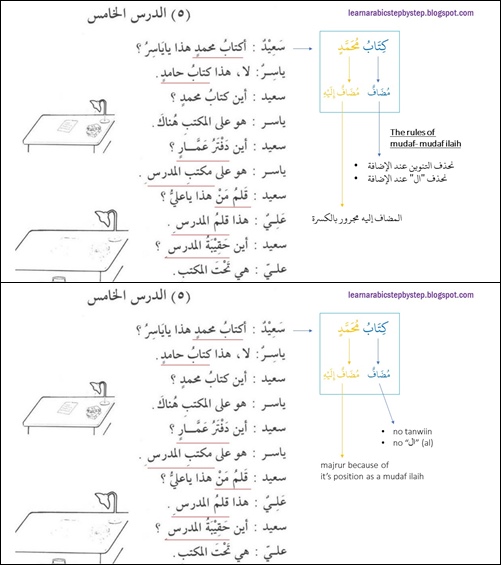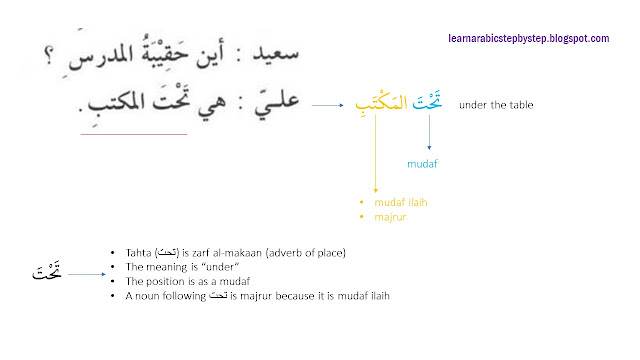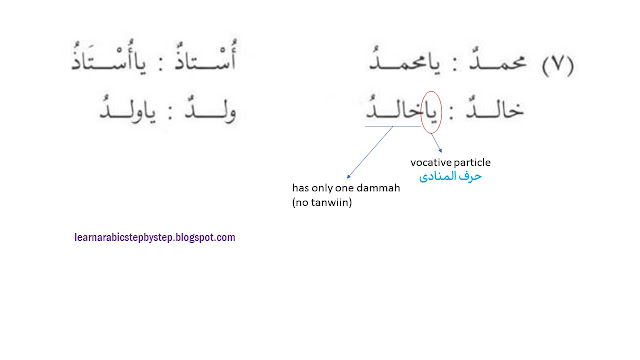Durus al-lughah Book 1 Lesson 5: Idafah basic structure and rules
Tabel of Content [View]
Have you studied huruful jar rules? If you finished that, you can continue on the newest lesson in this book (chapter 5). We are going to learn idafah basic structure and it's rules with some sentence examples using huruf al-jar.
Actually I've explained the idafah completely here mudaf mudaf ilaihi meaning, rules, and examples. But, if you are a beginner or just starting to learn Arabic through durus al-lughah al-Arabiyyah book, then you should learn this chapter first.
As usual, you should observe the picture first, read the notes, then I will show you the points that we learn from the picture.
Idafah basic construction
Idafah meaning in English is “addition”, “attachment”, or “annexation”.
Idafah basic structure: Idafah consists of two nominal components, they are mudaf (مضاف) and mudaf ilaih (مضاف إليه).
Mudaf means "annexed", whereas mudaf ilaih means "annexer".
Idafah (إضافة) is a compound noun that expresses several things, but in this lesson, we only focus on the possessed and possessor relationship.
See the following picture.
Through the above picture, you can see that mudaf means “possessed” whereas mudaf ilaih means “possessor”.
Idafah basic rules
Before discussing the basic rules, let's read the Arabic text in this book and the meaning.
Once you finish and understand the meaning from idafah examples above, let's study the idafah basic rule.
From the picture above, we learn the idafah (mudaf mudaf ilaihi) basic rules:
1. kitaabu muhammadin (كِتَابُ مُحَمَّدٍ) means Muhammad's book or the book of Muhammad.
2. kitaabu is the first word, it is the thing possessed. It is called mudaf (مضاف).
muhammadin (مُحَمَّدٍ) is the second word, it is the possessor. It is called mudaf ilaih (مضاف إليه).
3. Basic rule of mudaf:
a. mudaf has no tanwiin.
b. mudaf has no definite article "al" (ال). Mudaf is definite by position, so it doesn't need the definite article.
4. Basic rule of mudaf ilaih:
a. the case of mudaf ilaih is majrur (مجرور).
b. mudaf ilaih can have tanwiin or definite article.
5. qalamu man? (قَلَمُ مَنْ) means "whose pen?"
a. qalamu is mudaf, whereas man is mudaf ilaih.
b. man is not majrur because man (مَنْ) is indeclinable.
2. kitaabu is the first word, it is the thing possessed. It is called mudaf (مضاف).
muhammadin (مُحَمَّدٍ) is the second word, it is the possessor. It is called mudaf ilaih (مضاف إليه).
3. Basic rule of mudaf:
a. mudaf has no tanwiin.
b. mudaf has no definite article "al" (ال). Mudaf is definite by position, so it doesn't need the definite article.
4. Basic rule of mudaf ilaih:
a. the case of mudaf ilaih is majrur (مجرور).
b. mudaf ilaih can have tanwiin or definite article.
5. qalamu man? (قَلَمُ مَنْ) means "whose pen?"
a. qalamu is mudaf, whereas man is mudaf ilaih.
b. man is not majrur because man (مَنْ) is indeclinable.
The case of mudaf
Mudaf ilaihi is always majrur, but mudaf's case depends on 'amil before it. So, mudaf can be marfu' (nominative), mansub (accusative), or majrur (genitive).
As you've seen in the picture above, all the examples show us that the case of mudaf is nominative ( harakat dammah "u" in the last letter).
There is one example shows us the case of mudaf which is genitive or majrur. Observe the picture below.
Through the picture above, we learn this thing:
1. 'ala maktabi al-mudarrisi (عَلَى مَكْتَبِ المُدَرِّسِ) means “on teacher's table”.
a. 'ala is a preposition (harf jar).
b. maktabi is mudaf. The case is genitive (majrur) because of the preposition 'ala (عَلَى).
c. al-mudarrisi is mudaf ilaih. The case is genitive (majrur) because it is mudaf ilaih.
a. 'ala is a preposition (harf jar).
b. maktabi is mudaf. The case is genitive (majrur) because of the preposition 'ala (عَلَى).
c. al-mudarrisi is mudaf ilaih. The case is genitive (majrur) because it is mudaf ilaih.
Zarf makan (adverb of place) as a mudaf
From the picture, we learn the following:
1. The example of adverb of place (ظرف المكان) ⇒ under = تَحْتَ (tahta)
2. A noun following تحت is majrur because it is mudaf ilaih.
tahta al-maktabi (تَحْتَ المَكْتَبِ) = under the table.
— tahta (تَحْتَ) is mudaf.
— al-maktabi (المَكْتَبِ) is mudaf ilaih. It's majrur (genitive).
The indication of the jar is kasrah "i".
2. A noun following تحت is majrur because it is mudaf ilaih.
tahta al-maktabi (تَحْتَ المَكْتَبِ) = under the table.
— tahta (تَحْتَ) is mudaf.
— al-maktabi (المَكْتَبِ) is mudaf ilaih. It's majrur (genitive).
The indication of the jar is kasrah "i".
Additional lesson in chapter 5
Personal pronoun (ism damir) for singular and feminine noun
You can see the picture above. Let's summarize the points.
1. The example of singular feminine noun (اسم مفرد مؤنّث) ⇒ a bag = حَقِيْبَةٌ (haqiibatun).
2. Personal pronoun (اسم ضمير) for singular and feminine noun is hiya (هِيَ).
We can use هِيَ for both human and non-human.
2. Personal pronoun (اسم ضمير) for singular and feminine noun is hiya (هِيَ).
We can use هِيَ for both human and non-human.
Vocative particle in Arabic
Vocative particle (harf al-munada) basic concept
1. yaa (يَا) is a vocative particle.
2. A noun following يَا has only one dammah (no tanwin).
Examples:
O Muhammad! = يَا مُحَمَّدُ
O teacher! = يَا أُسْتَاذُ
2. A noun following يَا has only one dammah (no tanwin).
Examples:
O Muhammad! = يَا مُحَمَّدُ
O teacher! = يَا أُسْتَاذُ










No comments:
Post a Comment